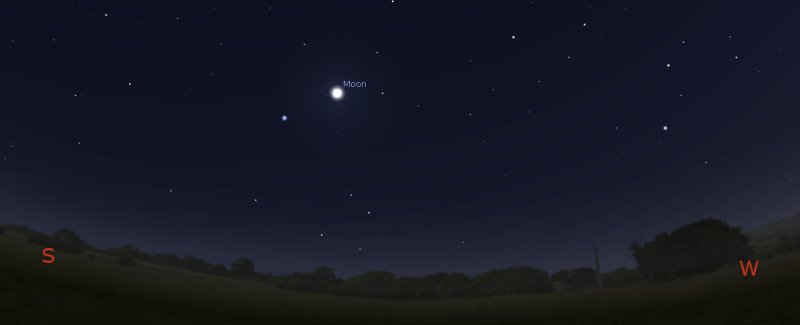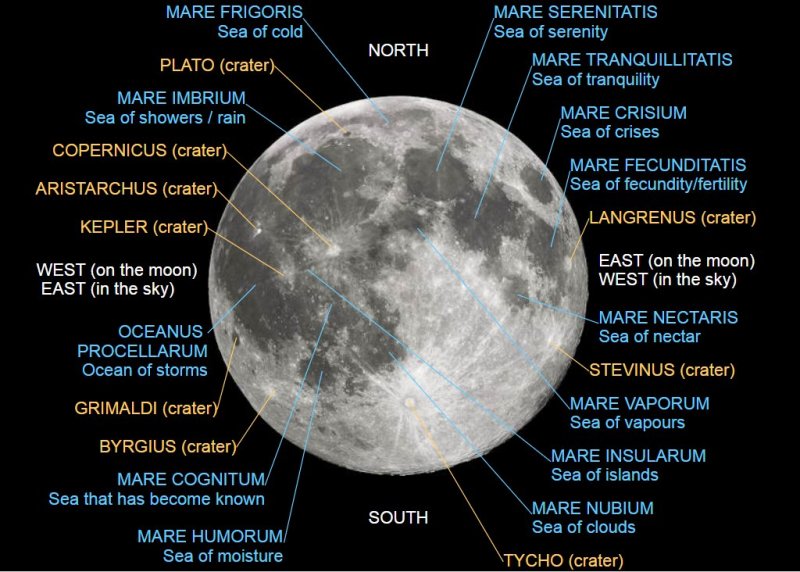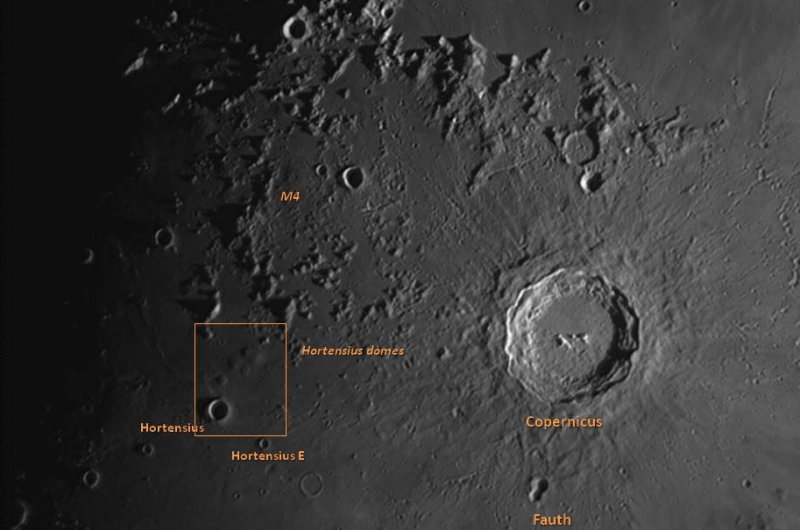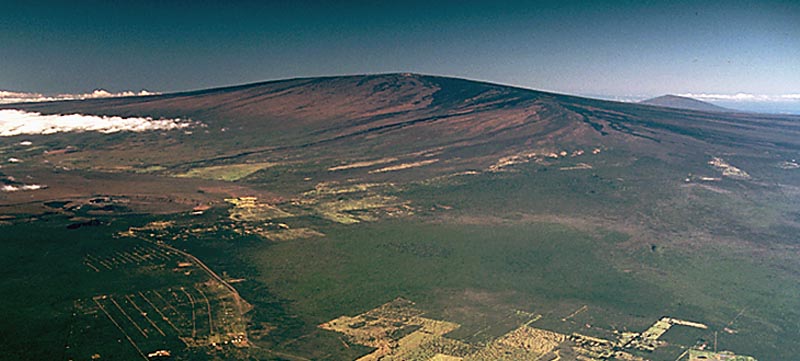|
Monday 25th to
Sunday 31st July 2022 |
| |
|
If it's still hot and you're having trouble
sleeping, there are a couple of great opportunities to see Venus alongside a
waning Crescent Moon in the early morning, about 4am local time. On Tuesday
26th the Crescent Moon will be 5%-lit and the following morning, it will
only be 2%. |
| |
|
You will find the pair close to the horizon,
slightly north of east. At the same time, the constellation of Taurus with
the Pleiades open cluster of stars M45 will be a bit higher up and due
east. Mars will be slightly to the south of east. Keep turning in that
direction and you will also be able to see Jupiter in the south east and
Saturn just past south. |
| |
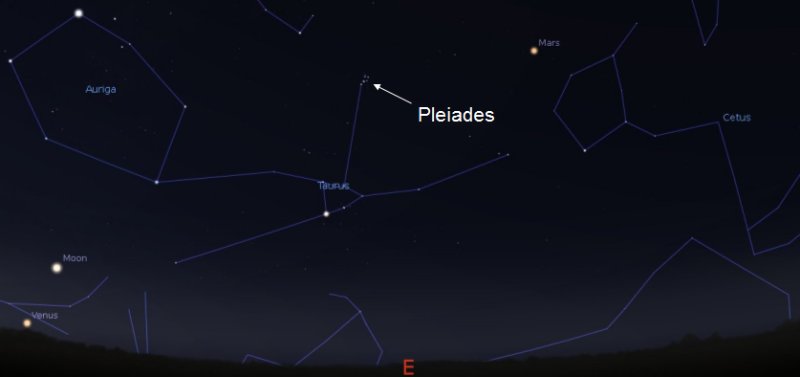 |
| |
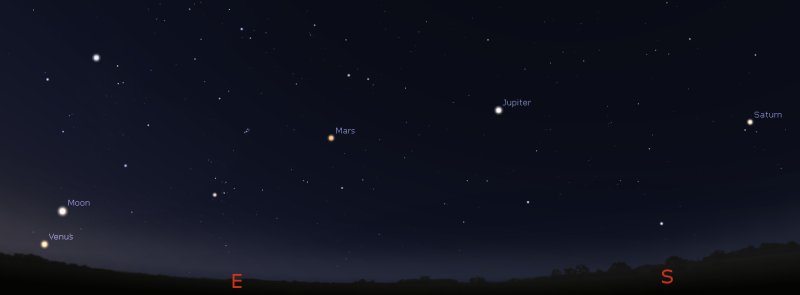 |
| |
|
All these objects are visible with the naked
eye, but binoculars or a small telescope will reveal the major stars of the
Pleiades in much more detail. If you would like a bit of a challenge, have
a go at trying to spot Uranus, which is located to the left of Mars. The
planet currently has a magnitude of around +6 so should be easy to see with
binoculars. A small telescope will start to show a turquoise disk. |
| |
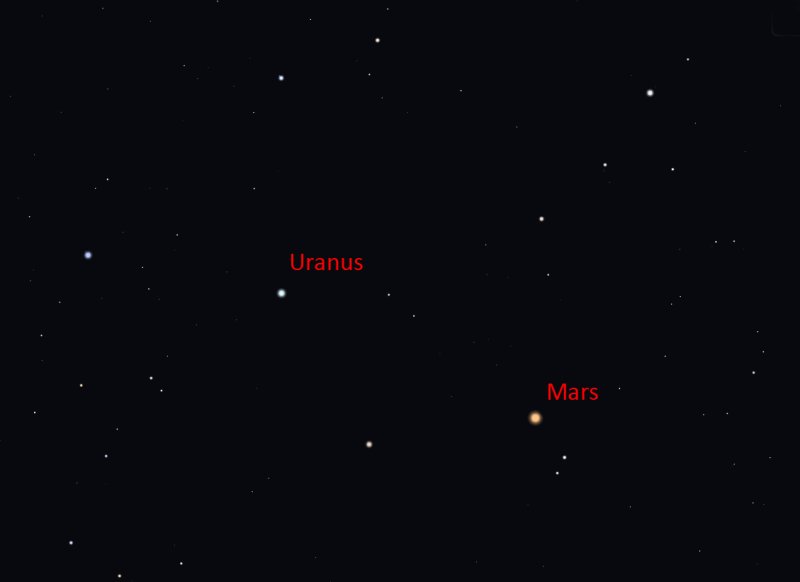 |
| |
|
Uranus is the third-largest planet in our
Solar System and is mainly composed of Hydrogen and Helium, with a few other
smelly ingredients like Ammonia and Methane! It has a system of rings
around it, although not as majestic as Saturn's and 27 known moons. One
unusual fact is that Uranus spins on its side, so the north and south poles
are actually left and right! |
| |
|
If you are using binoculars or a telescope,
please remember to pack them away before the Sun rises so that there is no
danger of accidentally catching a glimpse of it in the eyepiece. |
|
Monday 18th to
Sunday 24th July 2022 |
| |
|
Last week we focussed on the constellation of
Hercules that is located high up towards the south if you are out observing
just after it gets dark. Beside Hercules is the constellation of Lyra
and that's where we are going next. |
| |
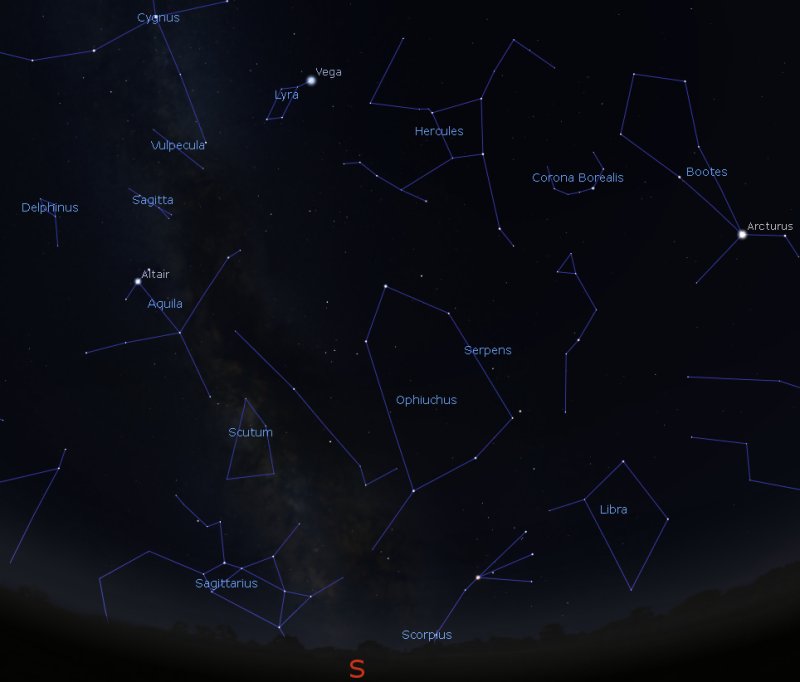 |
| |
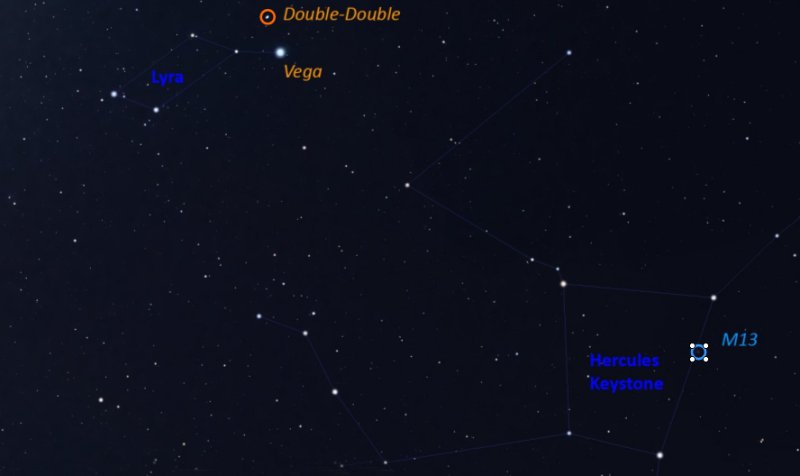 |
| |
|
The most obvious feature of Lyra is the
bright star Vega. The star is only 25 light years away from us and is the
third-brightest star in the night sky of the northern hemisphere. Vega is
only about 1/10th the age of our own Sun and it is classed as a "variable
star" because its brightness varies slightly. Curiously, it rotates rapidly
at a speed of 236Km/s and this makes it bulge in the middle. |
| |
|
Everyone is familiar with Polaris,
the "Pole Star" that marks the point in the night sky everything else
appears to rotate around. Well that isn't quite true and hasn't always
been the case! |
| |
|
When astronomers set-up an
equatorial telescope mount, they have to make a slight adjustment because
Polaris isn't exactly in the centre. |
| |
|
The Earth "wobbles" slightly on its
axis and its position relative to the stars, or "axial precession" to get
technical, changes over a period of 22,500 years. Vega was actually
the northern pole star around 12,000BC and will be again around the year
13,727AD. |
| |
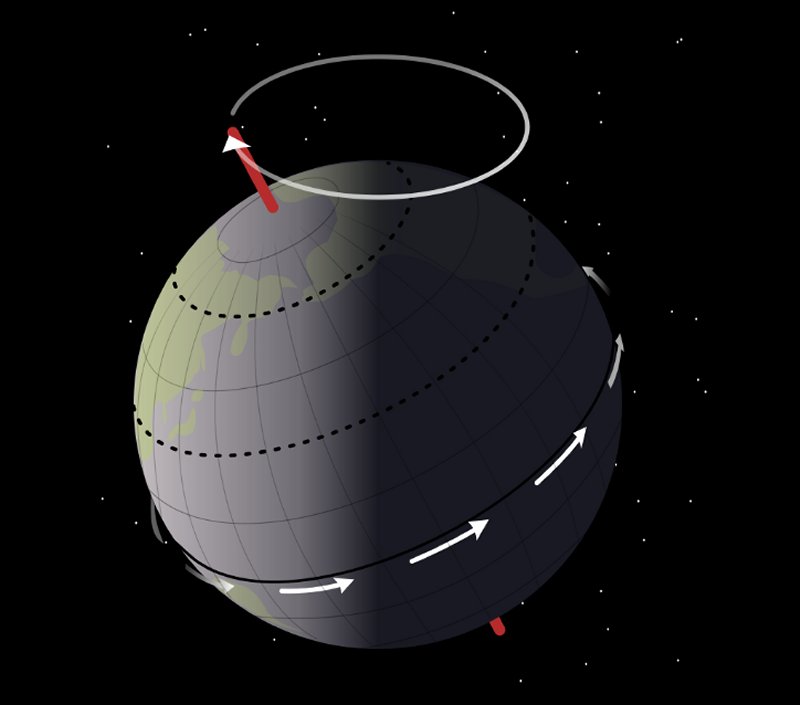 |
| |
|
Axial Precession diagram courtesy
of Wikipedia |
| |
|
Slightly to the left of Vega is the
"Double Double" star Epsilon Lyrae. With binoculars a binary star is
seen, but when observed with a telescope, each of these two stars is
revealed to be a double star - hence the name. Binary stars orbit
around each other due to mutual gravitational forces where double stars just
appear close together when viewed from the Earth. |
| |
 |
| |
|
Epsilon Lyrae photograph courtesy
of Nikolay Nikolov |
|
Monday 11th to
Sunday 17th July 2022 |
| |
|
If you look high up towards the south after
dark, have a go at spotting the constellations of Hercules and Lyra. |
| |
 |
| |
|
Just to the right of the "keystone" asterism
shape in the middle of Hercules is the Great Globular Cluster of stars, also
known as Messier 13. It contains over a million stars and is a great target
for binoculars or a small telescope. Binoculars will show it as a round
patch of light, where using a telescope will start to reveal the outer stars
as tiny pinpoints of light. |
| |
 |
| |
|
The cluster is estimated to be around 22,000
light years away from us. |
| |
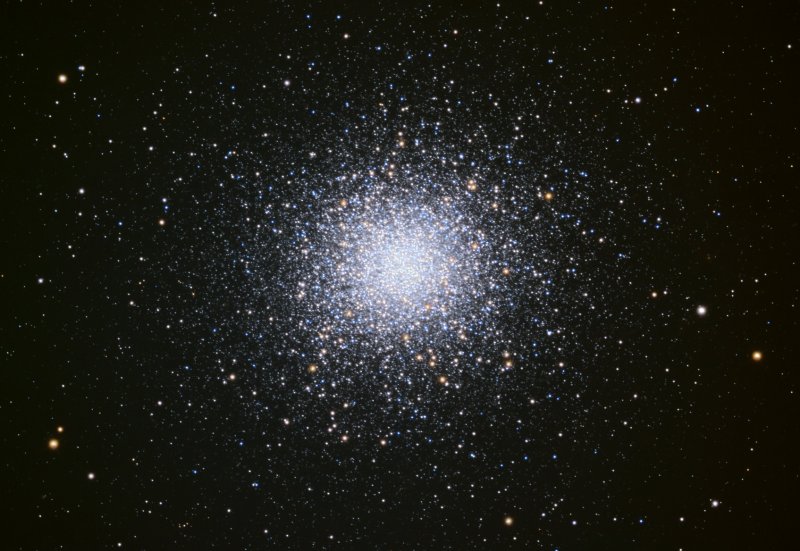 |
| |
|
M13 Photograph courtesy of the
Mount Lemmon Sky Centre |
| |
|
In 1974, a radio signal
that contained information about the human race, our DNA and Earth's
position was beamed from the Arecibo Observatory radio telescope towards M13
as an experiment in contacting potential extra-terrestrial civilizations in
the cluster. The cluster will move through space during the transit
time, so opinions differ as to whether or not M13 will be in a position to
receive the message when it arrives in 22,000 year's time! |
| |
|
Of course, if any aliens
send us a message back, that will take another 22,000 years to reach us! |
| |
|
Closer to home, there are a couple of
excellent opportunities to spot the International Space Station if you don't
mind staying up into the early hours of the morning. Tuesday 12th at 1.30am
and Wednesday 13th at 12.42am. In both cases, the ISS appears in the west
and spends 7 minutes passing almost directly overhead, before disappearing
towards the east. |
|
Monday 4th to
Sunday 10th July 2022 |
| |
|
Last week I talked about the constellation of
Sagittarius that can be found close to the south horizon after midnight. I
also suggested that if you have access to binoculars or a telescope, then
you could try spotting Messier 8, the Lagoon Nebula. |
| |
 |
| |
|
Just above the Lagoon Nebula is another great
target - the Trifid Nebula, also known as Messier 20. The name does not
originate from any science fiction story, but means "three lobes" and M20 is
an unusual combination of emission nebula where stars are born, a reflection
nebula where spent gas is illuminated by the stars nearby and a dark nebula
where the cloud is so dense that it absorbs the light coming from behind
it. For good measure, there is also an open cluster of stars within it. |
| |
 |
| |
|
The Trifid Nebula is estimated to be 4100
light years away from us and with a magnitude of around 6, binoculars or a
telescope will be needed to see it. You will observe a fuzzy blob, so I
have provided a photograph below that better-shows M20's complex details,
courtesy of the European Southern Observatory in Chile. |
| |
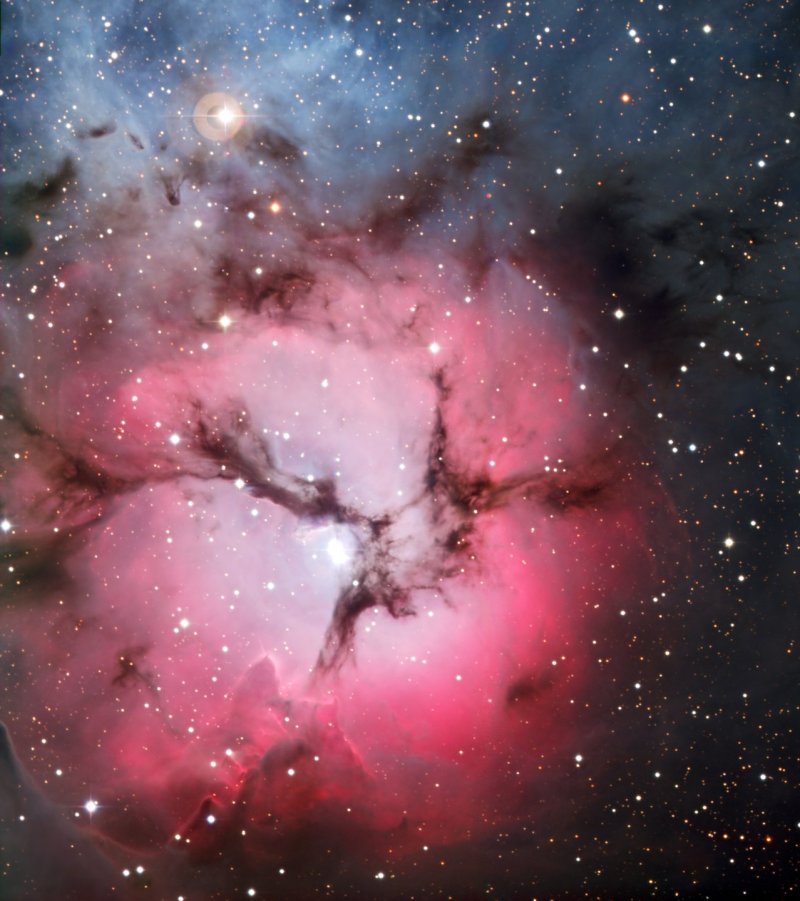 |
| |
|
I suppose I should wish everyone a "Happy
Aphelion Day" for Monday 4th July! Just like the Moon's orbit around us has
a Perigee and Apogee when it is slightly closer or further away from us, so
does our orbit around the Sun. The 4th July is "Aphelion" when we are the
furthest we get from the Sun during our year-long orbit around it. At that
point, we are 152 million Km or 94.5 million miles from the Sun. Perihelion
occurs in January and then we are about 5 million Km or 3 million miles
closer. Doesn't feel like we are closer though! |
|
Monday 27th June
to Sunday 3rd July 2022 |
| |
|
The end of June is an ideal time to see a
teapot with steam coming out of the spout! Have I gone completely mad? I'd
better explain.......... |
| |
|
There are 88 official constellations of stars
recognised by the International Astronomical Union. They all have familiar
names like Orion that are tied back to ancient mythology - Orion was the
Hunter. Another such constellation is Sagittarius, whose name is derived
from the Latin word for an archer with a bow and arrow. |
| |
|
If you look towards the south after midnight,
Sagittarius will be close to the horizon. |
| |
 |
| |
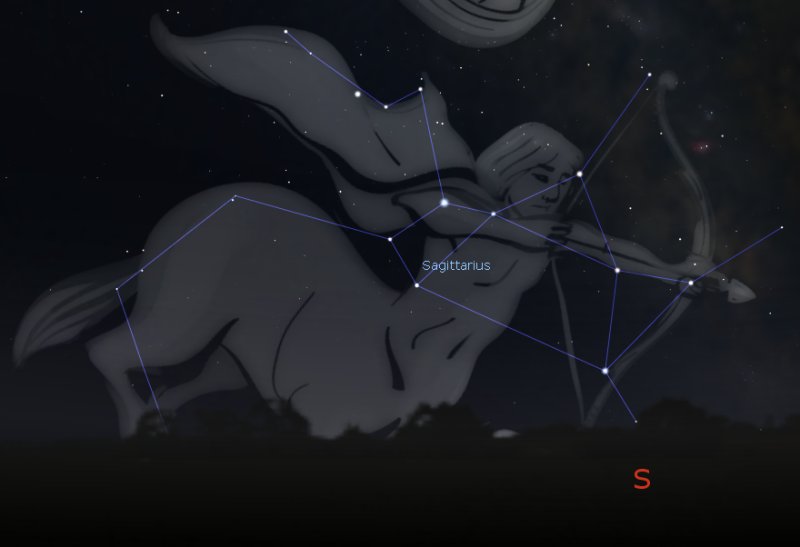 |
| |
|
Other patterns of stars that are easy to
spot, but are not official constellations are called "asterisms". Within
Sagittarius is the "teapot" asterism, so named because it looks like a
teapot with the handle to the left and spout to the right. From a dark sky
location, it is possible to see the Milky Way that resembles faint cloud -
actually millions of very distant stars in our galaxy. This cloud looks
like steam coming out of the teapot. |
| |
|
Just above and to the right of the teapot's
lid is a treat for binocular or telescope users - the Lagoon Nebula that is
also known as M8 in the Messier Catalogue. M8 is classed as an emission
nebula where ionised Hydrogen gives birth to new stars. The nebula is
estimated to be between 4000 and 6000 light years away from us and even with
simple binoculars it should be possible to make out a distinct patch of
fuzzy cloud with a bright centre. |
| |
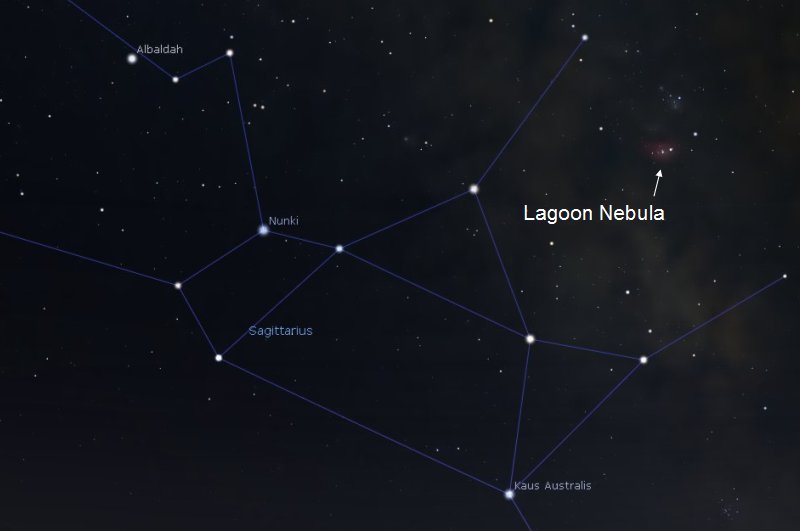 |
|
Monday 20th to
Sunday 26th June 2022 |
| |
|
There is a very special event taking place on
the morning of Friday 24th, but you will need to be up early, around 4am, to
catch it. It really will be worth the effort - so long as it's not cloudy. |
| |
|
If you look towards the east at that time,
there is an opportunity to see all seven of our neighbouring planets at
once! They will form a line running either side of due east. |
| |
|
From left to right..........Mercury very
close to the horizon, Venus, Uranus, Mars, Jupiter and Neptune, with Saturn
slightly further to the right. Uranus and Neptune will be too dim to
see with the naked eye, so you will need binoculars or a telescope to be
able to find them, but the others are easy to spot. As if that wasn't
enough, a Crescent Moon will be in the middle of the line-up as well. |
| |
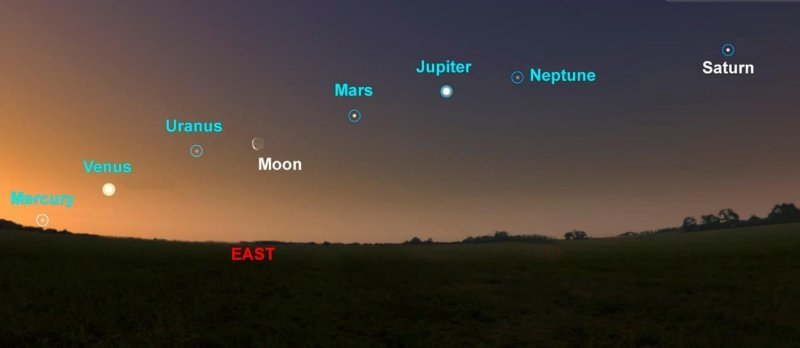 |
| |
|
Hang on..........at school I was taught that
there were nine planets in the Solar System, not seven. Well of course you
are stood on one of them - Earth. Little Pluto was "downgraded" to a minor
or "dwarf" planet by the International Astronomical Union back in 2006. It
was originally discovered by an American astronomy student called Clyde
Tombaugh in 1930. Pluto lives in the Kuiper Belt that contains many objects
orbiting the Sun at a greater distance than Neptune and the problem started
when during the 1990s we started to discover quite a few large objects out
there and there aren't enough Disney names to cover them all! |
| |
|
Technically, Pluto is classified as a dwarf
planet because it does not have enough mass to have cleared the space
immediately around it from other debris. |
|
Monday 13th to
Sunday 19th June 2022 |
| |
|
Nothing in space is a perfect circle. The
orbits of planets around the Sun are all elliptical or "egg shaped" to a
greater or lesser degree. The same is true for the Moon that orbits around
us. |
| |
|
The Moon takes just over 27 days to complete
one orbit and at different times it is slightly closer and further away from
the Earth. The closest it ever gets is 363,000 Km or 225,000 miles in old
money and this point is called "Perigee". The furthest point is called
"Apogee" and then it is 405,000 Km or 251,000 miles away from us. If you
forget which is which, just remember that at Apogee, the Moon is
"apologising" for being so far away! |
| |
|
On the evening of Tuesday 14th there is a
Full Moon. If you go outside a little before 11pm, the Moon will be rising
over the horizon towards the south east. This particular Full Moon is known
as a "Supermoon" because it occurs near Perigee when the Moon is closest to
us. |
| |
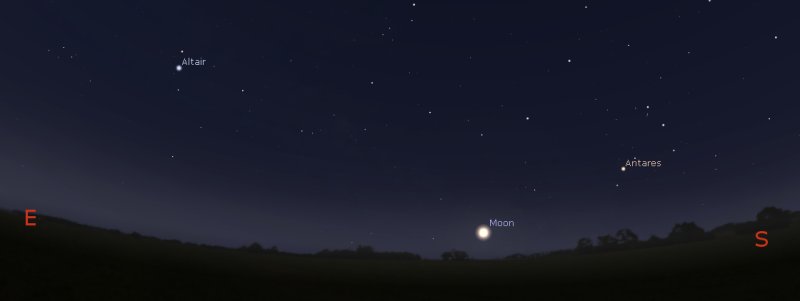 |
| |
|
There is also an optical effect called "Moon
Illusion" which occurs when the Moon is close to the horizon - your eyes and
brain play a trick on you and make the Moon seem artificially large. |
| |
|
Of course, a bright Full Moon is the ultimate
source of light pollution, so it is not the best time to go hunting for
faint deep sky objects, but it is a great chance to spot some of the larger,
more obvious lunar features. |
| |
|
Most
will be visible without even resorting to binoculars or a small telescope.
In fact, you are better off not using a telescope because a Full Moon can be
painfully bright without a special filter in your eyepiece. |
| |
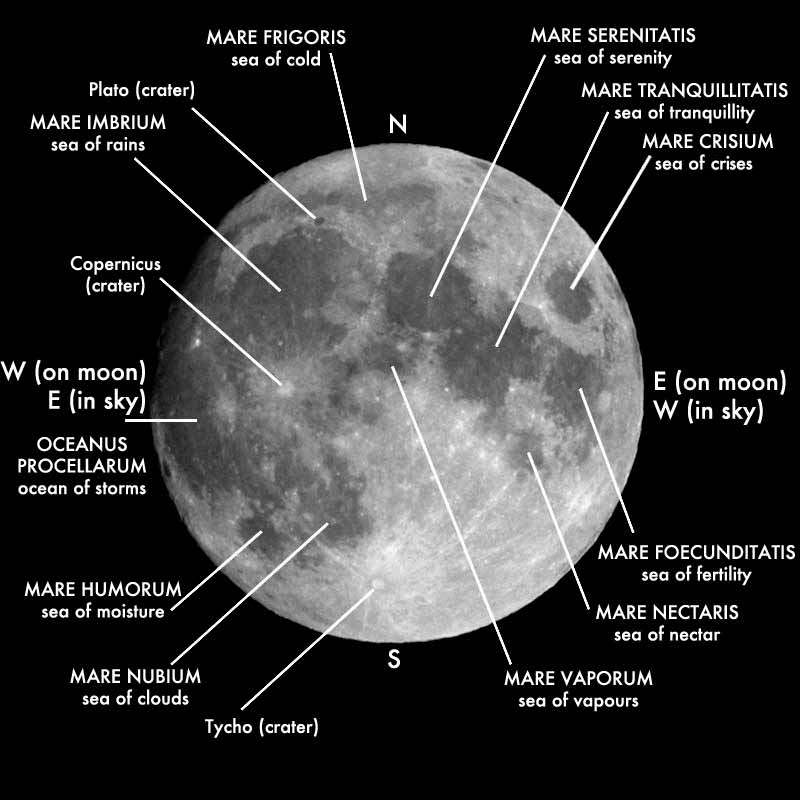 |
| |
|
Image courtesy of Wikipedia |
|
Monday 30th May to
Sunday 5th June 2022 |
| |
|
After their conjunction last week, there are
still some great opportunities to see Mars and Jupiter close together, but
you will need to be an early riser. Just before daybreak, say around
3.30am, the pair of planets will be located towards the east, fairly close
to the horizon.
At the same time, Saturn will be slightly
higher up, towards the south east. |
| |
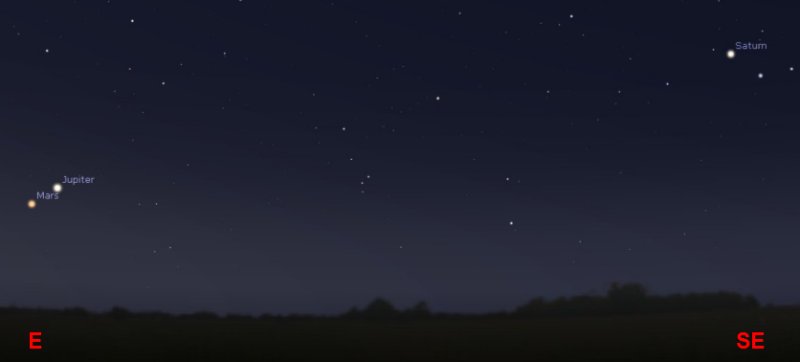 |
| |
|
If you are up at that time of day and fancy a
little challenge with your telescope or binoculars, you could have a go at
spotting one of Charles Messier's globular star clusters, M14. |
| |
|
First find the large constellation of
Ophiuchus slightly west of due south. It resembles a large box with a
pointed lid and the bright star, Rasalhague, is at the top. Then locate the
two stars Cebalrai and Sabik running down the left hand side of the
constellation. M14 is situated approximately one third of the way down from
Cebalrai and slightly to the left. |
| |
 |
| |
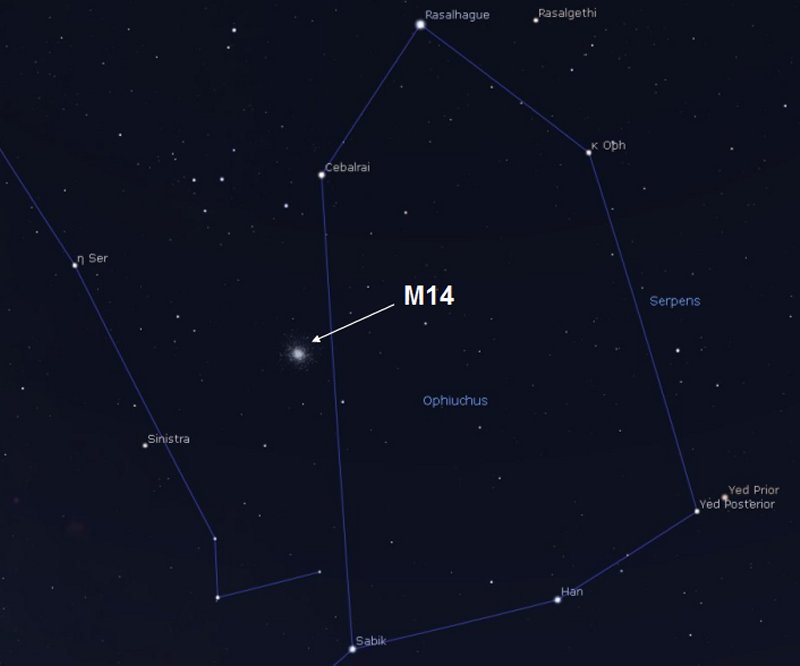 |
| |
|
The cluster is about 30,000 light years away,
so if you do go outside to observe it, you will be seeing the cluster how it
was 30,000 years ago because the light has taken that long to reach us! The
cluster contains several hundred thousand stars - with binoculars or a small
telescope, it will resemble a fuzzy blob. You would need a large telescope
to be able to start resolving individual stars within it. |
| |
|
The name Ophiuchus comes from the ancient
Greek word meaning "serpent bearer" and he is holding a snake, represented
by the adjacent constellation of Serpens. |
| |
 |
















